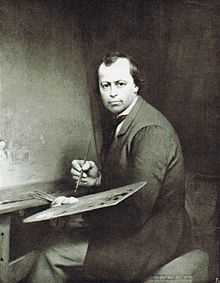Ferdinand de Braekeleer the Elder

Ferdinand de Braekeleer (Antwerp, 12 February 1792 - Antwerp, 16 May 1883), sometimes spelled as Ferdinand de Braeckeleer, was a Flemish painter.[1] He is known for his historical paintings and is called 'the Elder' to distinguish him from his son with the same name (Ferdinand de Braekeleer the Younger), who was also a painter.
Life
Ferdinand was born in a poor family. After his parents died he was admitted to the Art school for orphans of Mathieu Ignace van Brée in Antwerp.[2] He continued his education at the Royal Academy for Fine Arts of Antwerp. His paintings received several prizes in 1809 and 1811. In 1813 he made his reputation at the Salon de Paris with his work Aeneas die Anchises redt uit de brand van Troje ("Aeneas saving Anchises from the fire of Troy"). [3]
Early on, De Braekeleer decided that he wanted to make a living as a painter and he tried out several genres to find out which one would most likely bring him most success. In addition to historical paintings, he also painted religious paintings, such as St. Sebastiaan for the Church of Our Lady of the Vineyard in Wijnegem (current location unknown).[3][4]
At the Antwerp art exhibition of 1819 he exhibited four paintings,[2] of which Tobias bezorgt het zicht aan zijn vader terug (Tobias Restoring his Father's Sight) won him the Dutch Prix de Rome in the category of historical paintings. This prize provided him with a scholarship that allowed him to study in Italy to improve his skills. He spent 1821 and 1822 in Italy. Together with his tutor Van Brée (who joined him in Rome) he visited several Italian cities, including Naples, Ancona, Firenze, Bologna and Venice. Fascinated by these Italian cities and their landscape, he filled a sketch book with crayon drawings of landscapes and city views, which is currently on display in the Bibliotheque Royale Albert (Royal Albert Library) in Brussels.
After his return to Belgium, De Braekeleer lived in his home town Antwerp. He created works inspired by the old Flemish masters. He primarily focused on historical paintings. One of these is the painting De Citadel van Antwerpen na het bombardement van 1832 (The citadel of Antwerp after the bombardment of 1832). Partially because of his paintings about the 1832 bombardments by the Dutch, he became an influential artist in Belgium after the independence of Belgium. His two sons, Ferdinand the Younger (1828 - 1857) and Henri de Braekeleer (1840 - 1888) followed in their father's footsteps and also became painters. His nephew Adriaan Ferdinand de Braekeleer (1818 - 1904), was also a painter. Besides his sons, he tutored several other painters who became influential, such as Jan August Hendrik Leys and Ernest Slingeneyer.
Pupils[1]
- Louis Antoine Carolus
- Hendrik Joseph Gommarus Carpentero
- Adriaan Ferdinand De Braekeleer
- François Antoine De Bruycker
- Xavier De Cock
- Joseph Dens
- Robert van Eijsden
- Willem Jodocus Mattheus Engelberts
- Leopold Fisoette
- Napoléon François Ghesquière
- Paul Haesaert
- Aloïs Pieter Paul Hunin
- Jacob Jacobs
- Johan Janssens (1809 - 1855?)
- Eduard Knudden
- Jan Baptist Lammens
- Jan August Hendrik Leys
- Petrus Marius Molijn
- Florent Mols
- Aimé Pez
- Willem Rikkers
- Louis Somers
- Charles Venneman
- Constant Wauters
- Pierre Joseph Witdoeck
Work
(incomplete overview)[5]
- Aeneas die Anchises redt uit de brand van Troje ("Aeneas carrying Anchises from the fire of Troy"), 1813
- Tobias bezorgt het zicht aan zijn vader terug (Tobias Restoring his Father's Sight), 1819; unknown current location
- St.Sebastiaan;[3] unknown current location
- Oestereters (Eating oysters), 1829; collection gemeentemuseum?[6]
- De Citadel van Antwerpen na het bombardement van 1832 (The citadel of Antwerp after the bombardment of 1832); on display in Royal Museum of Fine Arts, Antwerp
- Herbergscène met muzikanten (Tavern scene with musicians), 1843 based on work by Adriaen van Ostade[7]
- Beleg van Haarlem (Siege of Haarlem); on display in Teylers Museum
- Interieur met boeren (Farmhouse with peasants), drawing. On display in Schlossmuseum Weimar[8]
- Oude jager met jong meisje (Old hunter with young woman), 1867; private collection[9]
Bibliography
- P. & V. Berko, "Dictionary of Belgian painters born between 1750 & 1875", Knokke 1981, p. 152-155.
- P. & V. Berko, "19th Century European Virtuoso Painters", Knokke 2011, p. 498, illustrations p. 442.
References
| Wikimedia Commons has media related to Ferdinand de Braekeleer the Elder. |
- ↑ 1.0 1.1 Rijksbureau voor Kunsthistorische Documentatie on de Braekeleer, alternative spelling (Dutch)
- ↑ 2.0 2.1 Roeland van Eijnden & Adriaan van der Willigen, Geschiedenis der Vaderlandsche Schilderkunst, Second part p.377 (Dutch)
- ↑ 3.0 3.1 3.2 The Concise Grove Dictionary of Art via Answers.com
- ↑ Ferdinand de Braekeleer on alleskunst.net (German)
- ↑ "Overview of a part of his work on". Invaluable.com. Retrieved 2013-06-24.
- ↑ Oestereters at RKD
- ↑ Herbergscène met muzikanten at RKD
- ↑ Interieur met boeren at RKD
- ↑ Oude jager met jong meisje at RKD